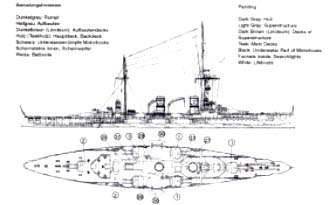WSW 1/700 SMS Blücher |  | History In 1905, Great Britain began work on a new type of warship that would be faster than armored cruiser and armed with a battleship's 12-inch guns. These ships would be called battlecruisers. Because construction of these large ships could not be kept a secret, the British mislead the world into thinking they were building large armored cruisers armed with 9.2-inch guns. As a result, Germany built a warship to match them, the Blücher with 8.3-inch guns. Blücher was designed with her twelve 8.3" guns in six twin turrets laid out in a hexagon, serving as a prototype design for later, contemporary German battleships. The Blücher ultimately faced the type of ship she had been designed to fight at Dogger Bank in January of 1915. Already too weakly armed to match the battlecruisers one-to-one and too slow to escape them, Blücher ended up in an unequal duel with four battlecruisers a light cruiser and destroyers. One of the most well-known photos of World War I naval combat shows the Blücher rolling over while her crew scrambled for safety over her sides. Out of a complement of 1,036, 792 perished. The Kit The kit came to me with the box filled with Styrofoam peanuts and all the parts packed in bubble wrap sleeves. The model made it to Texas all the way from Germany by surface mail with no breakage. The hull piece is 9 3/16 inches long and superbly cast with no pits or bubbles. There is some flash around the waterline that will be easily removed with a couple of swipes of sandpaper. The deck planking and fittings are gorgeous. The bulkheads on the superstructure are so thin they are translucent. A handful of brass rods are cast into the hull, sticking up out of the 'midships deck, to help in assembling the boat deck. Even the torpedo nets are cast integrally with the hull, however, the booms and shelf will have to be added with styrene strip and rod. Because the superstructure is cast onto the hull piece, assembly will be easier than with other kits that require superstructure assembly. It also means there are fewer parts. A single resin wafers holds 28 parts. The gun turrets (with guns integrally cast) smoke stacks, searchlight platform and a few small guns are cast separately. Eight ships' boats, nine searchlights, three small guns and the two derricks are all cast on resin sprue. Although resin parts are included for most of the fore and main masts, the instructions require using aftermarket brass rod to make up the rear tripod supports of the foremast and the spars of both masts. The instructions are printed double-sided on two 81/2 by 11" sheets of white paper. The only text is a German/English painting guide. The first page has a numbered breakdown of all the parts, excluding the hull/superstructure. The second page shows a side and top view of the Blücher with some of the parts identified and includes the aforementioned painting guide. The third and fourth pages have exploded-view close-up diagrams of the more complicated assemblies. Conclusion WSW has done an outstanding job in providing a detailed, crisply molded model of this ship. Very little work will be needed to turn out a high-quality model. The addition of etched brass railings will put this model over the top. Those who wish to rig it should use the resin mast pieces as a template and replace them with brass rod. | 








|